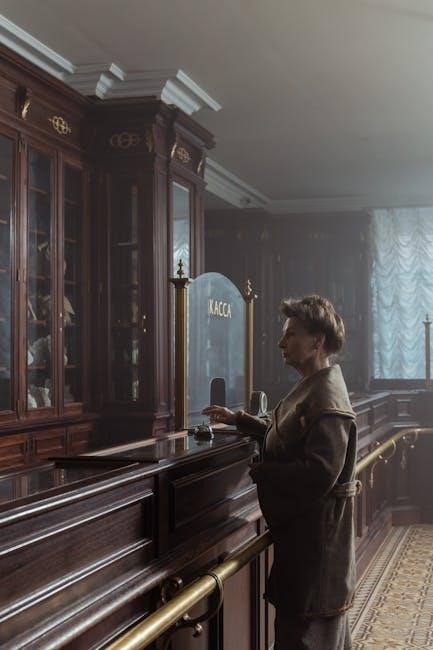the battle hymn of the tiger mother pdf
Amy Chua’s memoir, Battle Hymn of the Tiger Mother, explores her strict parenting style with humor and honesty. It sparked controversy, discussing extreme parenting’s rewards and costs, available as a PDF.
Background and Overview of the Book
Battle Hymn of the Tiger Mother is a memoir by Amy Chua, first published in 2011. The book chronicles Chua’s experiences raising her two daughters, Sophia and Lulu, using strict, traditional Chinese parenting methods. Chua, a Yale Law professor and daughter of Chinese immigrants, contrasts her approach with Western parenting styles, emphasizing high expectations, rigorous discipline, and a focus on academic and musical excellence. The memoir sparked widespread debate due to its controversial portrayal of “tiger parenting,” which includes intense pressure on children to succeed and little tolerance for failure. The book is both humorous and introspective, offering insights into the cultural and familial dynamics that shaped Chua’s parenting philosophy. While some praised the book for its honesty and cultural perspective, others criticized its extreme methods, leading to a polarized public reaction. The memoir is available in PDF format, allowing readers to engage with Chua’s story digitally. Overall, it remains a significant work in discussions about parenting, culture, and identity.
The Author: Amy Chua
Amy Chua is an American author, lawyer, and professor at Yale Law School. Born to Chinese immigrant parents, Chua’s background deeply influenced her writing and parenting philosophy, as detailed in her memoir. Her work often explores themes of culture, identity, and achievement, making her a prominent voice in discussions about parenting and education. Chua’s writing is known for its candor and wit, as seen in her bestselling book Battle Hymn of the Tiger Mother, which has been widely read and debated. Available in PDF format, her work continues to attract readers interested in understanding the complexities of traditional parenting methods and their impact on family dynamics. Chua’s perspectives have sparked both praise and criticism, cementing her role as a thought-provoking figure in contemporary discourse on parenting and culture.

Key Themes and Messages in the Book
The book explores strict parenting, cultural values, and the pursuit of excellence, revealing the tension between high achievement and emotional well-being, as detailed in the PDF of Amy Chua’s memoir.
The Concept of Tiger Parenting
Tiger parenting, as detailed in Amy Chua’s Battle Hymn of the Tiger Mother, emphasizes strict discipline, high expectations, and rigorous academic and extracurricular pursuits. Chua advocates for an demanding approach, believing it ensures success and resilience in children. This method, rooted in her Chinese heritage, contrasts sharply with Western parenting styles. The PDF version of the book highlights her belief that children should prioritize family honor and achieve excellence through relentless effort. Critics argue this approach can lead to emotional strain, while supporters see it as a path to exceptional achievement. Chua’s memoir, available as a PDF, chronicles her daughters’ journeys under this intense parenting style, blending humor with introspection on the costs and rewards of her methods.
Cultural Differences in Parenting Styles
Amy Chua’s Battle Hymn of the Tiger Mother highlights stark cultural differences in parenting approaches, contrasting Chinese and Western methods. Chua, raised by Chinese immigrant parents, adheres to a strict, achievement-focused style, emphasizing rigorous academic and extracurricular dedication. In the PDF version, she describes demanding long practice hours for her daughters and pushing them to excel, reflecting the cultural belief that hardship builds resilience. This contrasts with Western parenting, which often prioritizes children’s happiness and self-expression. Chua’s memoir sparks debate about these differing philosophies, with critics accusing her of emotional harshness, while supporters argue her methods yield high-achieving children. The book, available as a PDF, explores how cultural values shape parenting, offering insights into the tension between tradition and modern approaches to raising children. Chua’s perspective underscores the broader cultural divide in parenting, making it a focal point of discussion in her work.
The Role of Music and Academic Excellence
In Battle Hymn of the Tiger Mother, Amy Chua emphasizes the central role of music and academic excellence in her parenting philosophy. She insists that her daughters master classical instruments, with Sophia excelling at piano and Lulu at violin, aiming for performances at Carnegie Hall. Chua believes these pursuits cultivate discipline, focus, and achievement, reflecting the high value she places on intellectual and artistic rigor. The PDF version of her memoir highlights how she pushed her children to practice for hours daily, often sacrificing playtime and extracurricular activities. This approach contrasts sharply with Western parenting, which may prioritize sports or social activities. Chua’s focus on music and academics underscores her belief that excellence in these areas is essential for success and a source of family pride. Her methods, while controversial, illustrate the intensity of her commitment to nurturing exceptional talent in her children.
The Rewards and Costs of Strict Parenting

Amy Chua’s Battle Hymn of the Tiger Mother delves deeply into both the rewards and costs of her strict parenting approach, as outlined in the available PDF. On one hand, her daughters achieved exceptional success: Sophia excelled in piano, while Lulu mastered the violin, both performing at Carnegie Hall. These achievements reflect Chua’s belief that strict discipline and high expectations yield remarkable results. However, the costs were significant, including emotional strain and rebellious behavior from her children. Chua faced criticism for her methods, which some labeled as abusive, though she maintains her approach was rooted in love and a desire for her children to thrive. The PDF version of her memoir reveals the complexity of her parenting journey, balancing pride in her daughters’ accomplishments with regret over the emotional toll it took on their relationship. This duality makes Chua’s story a compelling exploration of the consequences of extreme parenting.
Amy Chua’s Parenting Philosophy
Amy Chua advocates for strict, demanding parenting, emphasizing high expectations and sacrifice. Her philosophy, detailed in the PDF of Battle Hymn of the Tiger Mother, prioritizes excellence over Western notions of self-esteem, reflecting her cultural heritage.
High Expectations and Strict Discipline
Amy Chua’s parenting philosophy, as outlined in the PDF of Battle Hymn of the Tiger Mother, centers on setting exceptionally high expectations for her children. She believes in pushing her daughters, Sophia and Lulu, to achieve excellence through relentless effort and strict discipline. Chua views failure as unacceptable and emphasizes the importance of hard work and resilience. Her approach includes demanding long hours of practice for music and academics, often sacrificing her children’s free time for the pursuit of perfection. This strict regimen is rooted in her cultural upbringing and the belief that children can overcome any obstacle with enough dedication. While some criticize her methods as harsh, Chua argues that her tough love prepares her children for the challenges of life, fostering strength and success. Her philosophy has sparked widespread debate, with many questioning the balance between discipline and emotional well-being.
The Importance of Sacrifice in Parenting

In Battle Hymn of the Tiger Mother, Amy Chua emphasizes the importance of sacrifice as a cornerstone of her parenting approach. She believes that parents must prioritize their children’s success above personal comfort, often requiring significant personal sacrifices. Chua recounts how she devoted countless hours to overseeing her daughters’ rigorous practice schedules for music and academics, even at the expense of her own time and energy. This philosophy is deeply rooted in her cultural heritage, where parental sacrifice is seen as a duty to ensure a child’s future prosperity. Chua argues that such sacrifices are necessary to cultivate resilience and achievement in children, preparing them for life’s challenges. While some critics view her methods as extreme, Chua maintains that the rewards of raising high-achieving, disciplined children justify the personal costs. Her memoir highlights the tension between parental dedication and the emotional toll it can take on both parents and children.
Eastern vs. Western Parenting Approaches
Amy Chua’s Battle Hymn of the Tiger Mother starkly contrasts Eastern and Western parenting styles. Chua, raised by Chinese immigrant parents, adopts an Eastern approach emphasizing strict discipline, high expectations, and Sacrifice. She demands excellence from her daughters, pushing them to master music and academics. In contrast, Western parenting often prioritizes children’s happiness and self-expression, with more lenient expectations. Chua argues that the Eastern method produces resilient, high-achieving children, while Western parents risk coddling their kids. Her memoir highlights cultural differences in child-rearing, sparking debate over which approach yields better outcomes. While some praise her dedication, others criticize her methods as overly harsh. The book underscores how cultural values shape parenting choices, reflecting broader societal attitudes toward family and education. Chua’s perspective challenges readers to reflect on their own parenting beliefs and the cultural influences that guide them. Her story serves as a catalyst for discussions on the pros and cons of different parenting philosophies.
The Impact of “The Battle Hymn of the Tiger Mother”
Amy Chua’s memoir sparked global controversy, igniting debates on parenting styles and cultural values. Its influence reshaped discussions on education and child-rearing, leaving a lasting mark on modern parenting discourse worldwide.
Public Reaction and Controversy
Amy Chua’s Battle Hymn of the Tiger Mother ignited intense public debate, with critics accusing her of emotional abuse and supporters praising her unconventional approach. The book became a bestseller, sparking global discussions on parenting styles. Many found her methods, such as denying playdates and demanding perfection, extreme, while others admired her dedication to her daughters’ success. The memoir’s controversial nature led to widespread media coverage, with essays, interviews, and reviews flooded across major platforms. Chua received both admiration and backlash, with some labeling her a “Tiger Mother” and others questioning the ethics of her parenting. The book’s impact was amplified by its availability in PDF and digital formats, making it accessible worldwide. Despite the criticism, Chua’s unflinching honesty resonated with many, sparking a broader conversation about cultural differences in parenting and the pressures faced by immigrant families. The controversy surrounding the book remains a pivotal moment in modern parenting discourse.
Media Coverage and Reviews
Battle Hymn of the Tiger Mother received extensive media coverage, with reviews highlighting its provocative nature. Major outlets criticized Chua’s strict methods, while others praised her honesty. The book’s PDF version made it widely accessible, fueling debates. Critics labeled her approach harsh, yet the memoir resonated with many, sparking discussions on parenting and culture.
Long-Term Influence on Parenting Debates

Battle Hymn of the Tiger Mother has left a lasting impact on parenting discussions worldwide. Its controversial themes sparked debates about strict vs. nurturing parenting styles. Many critics argued that Chua’s approach, as detailed in the PDF version, promoted harmful expectations, while supporters saw it as a reflection of cultural values. The book challenged Western parenting norms, encouraging parents to reconsider their approaches. Its influence extended beyond personal parenting choices, shaping academic and cultural discussions about child-rearing. The memoir remains a key reference in debates about education and family dynamics, highlighting the tension between achievement and emotional well-being. Chua’s ideas continue to inspire both admiration and criticism, ensuring her work remains relevant in modern parenting conversations. The PDF format has made the book accessible to a global audience, further amplifying its impact on parenting philosophies and cultural perceptions.
Criticisms and Controversies Surrounding the Book
Battle Hymn of the Tiger Mother faced intense criticism for its strict parenting methods, sparking public backlash. Critics accused Chua of emotional abuse and cultural stereotyping, while others defended her approach. The PDF version fueled debates on parenting styles and cultural expectations, with Chua responding to the controversy.

Accusations of Emotional Abuse
Amy Chua faced intense criticism for her strict parenting methods, with many accusing her of emotional abuse. Critics argued that her demanding approach, as detailed in the PDF of Battle Hymn of the Tiger Mother, caused psychological harm to her children. Chua’s insistence on perfection, harsh verbal criticism, and lack of empathy were highlighted as abusive behaviors. Some readers and reviewers felt that her methods crossed the line into manipulation and control, undermining her daughters’ self-esteem. The public backlash was fueled by Chua’s admission of berating her children, calling them names like “garbage,” and rejecting their imperfections. These revelations sparked widespread outrage, with many questioning the ethical implications of such parenting. Despite her intentions to prepare her children for success, the emotional toll of her actions became a central point of controversy in the debate over her methods.
Cultural Stereotyping and Misrepresentation
Amy Chua’s Battle Hymn of the Tiger Mother has been criticized for perpetuating cultural stereotypes about Asian parents. Critics argue that her portrayal of “Tiger Parenting” oversimplifies the diverse experiences of Asian-American families, reducing them to a single, rigid archetype. The book’s focus on strict, demanding parenting reinforced harmful stereotypes about Asian parents being cold, unfeeling, and overly focused on achievement. Some readers felt that Chua’s narrative generalized the complexities of Asian cultures, ignoring the diversity of parenting styles within these communities. Additionally, her emphasis on the superiority of Chinese parenting methods was seen as dismissive of Western approaches, further polarizing the debate. While Chua intended to share her personal story, critics contend that her memoir inadvertently contributed to cultural misrepresentation, reinforcing biases and narrowing the understanding of Asian-American experiences. This criticism highlights the challenges of discussing cultural differences without oversimplification, as seen in the PDF version of her book.
Chua’s Response to Critics

Amy Chua has actively addressed the criticism surrounding her memoir, Battle Hymn of the Tiger Mother. She acknowledged the intense backlash, stating that her book was often misunderstood and that many readers missed its satirical undertones. Chua emphasized that her parenting approach, though strict, was rooted in love and a desire to prepare her children for success in a competitive world. She also clarified that her methods were not meant to represent all Asian parents but rather her own unique experience. Chua admitted that some critics’ accusations of emotional abuse were painful but maintained that her daughters thrived under her guidance. In response to allegations of cultural misrepresentation, she argued that her story was deeply personal and not intended to generalize Asian-American families. Chua’s defense underscores her belief in the validity of her parenting philosophy, even as she acknowledges the controversy it sparked. Her responses, available in the PDF version of her book, reflect her resilience and commitment to her values.

Cultural Significance of the Book
Battle Hymn of the Tiger Mother holds significant cultural value, sparking global debates on parenting styles and cultural identity. Available as a PDF, it reflects Asian-American experiences and challenges traditional Western parenting norms, influencing modern discourse on family dynamics and cultural expectations.
Representation of Asian-American Experiences
Battle Hymn of the Tiger Mother offers a profound exploration of Asian-American identity, delving into the complexities of cultural heritage and family dynamics. Amy Chua, an American-born daughter of Chinese immigrants, shares her journey of balancing traditional Asian values with Western cultural influences. The memoir highlights the challenges of navigating dual identities, particularly in parenting, where strict, expectation-driven upbringing contrasts with more lenient Western approaches. Chua’s experiences resonate deeply with many Asian-Americans who grapple with similar tensions between honor, sacrifice, and individual freedom. The book also sheds light on the immigrant experience, where preserving cultural roots often clashes with assimilation. By chronicling her family’s story, Chua provides a relatable and poignant portrayal of the Asian-American experience, sparking conversations about cultural identity and the sacrifices made by immigrant families. Available as a PDF, the memoir remains a vital resource for understanding these dynamics.

Influence on Modern Parenting Discourse
Amy Chua’s Battle Hymn of the Tiger Mother has profoundly influenced modern parenting discourse, igniting debates about parenting styles and cultural values. The book, available as a PDF, challenges Western parenting norms by advocating for strict, achievement-oriented methods rooted in Chua’s Chinese heritage. Her approach, which emphasizes intense academic and musical training, sparked controversy but also resonated with many parents seeking alternative strategies. The memoir’s release in 2011 coincided with growing discussions about helicopter parenting and the pressures of modern childhood. Chua’s arguments about the superiority of “tiger parenting” have been both praised and criticized, but they undeniably shifted the conversation. The book has inspired countless articles, talks, and studies, making it a pivotal work in contemporary parenting debates. By sharing her experiences, Chua has become a central figure in discussions about the role of culture and expectation in raising children, leaving a lasting impact on how parents reflect on their own approaches. The PDF version of the book continues to be widely read, ensuring its influence endures.

Reflection of Immigrant Family Dynamics
Amy Chua’s Battle Hymn of the Tiger Mother offers a compelling reflection of immigrant family dynamics, particularly within Asian-American households. The memoir, available as a PDF, captures the challenges and tensions that arise when traditional cultural values clash with modern Western expectations. Chua’s experiences as an American-born daughter of Chinese immigrants from the Philippines provide a unique lens through which to explore these dynamics. Her strict parenting methods, rooted in her cultural upbringing, highlight the immigrant desire to preserve heritage while navigating a new world. The book delves into the sacrifices made by immigrant parents to ensure their children’s success, often at personal cost. Chua’s narrative also reveals the generational conflicts that can emerge, as her daughters, raised in America, struggle with the expectations set by their mother. The PDF version of the book has made this exploration accessible to a wider audience, fostering empathy and understanding for the complexities faced by immigrant families. By sharing her story, Chua sheds light on the universal immigrant experience of balancing tradition and assimilation.
Battle Hymn of the Tiger Mother remains a provocative exploration of parenting and culture. Its impact, even as a PDF, continues to spark debates on family dynamics and cultural identity.
The Legacy of “The Battle Hymn of the Tiger Mother”
Amy Chua’s memoir has left an enduring mark on parenting discussions worldwide. Available as a PDF, it continues to challenge traditional notions of child-rearing. By blending personal anecdotes with cultural insights, Chua’s work has sparked a global dialogue on the balance between discipline and nurturing. The book’s exploration of Asian-American experiences and the immigrant family dynamics has resonated deeply, making it a significant cultural touchstone. Despite the controversy, its influence remains undeniable, shaping modern parenting debates and encouraging parents to reflect on their own approaches. The legacy of Battle Hymn of the Tiger Mother lies in its ability to provoke thought and inspire change, ensuring its relevance for years to come.
Final Thoughts on Parenting and Culture
Battle Hymn of the Tiger Mother challenges readers to rethink parenting practices and cultural norms. Amy Chua’s memoir, available as a PDF, highlights the tension between strict, tradition-driven parenting and more permissive Western approaches. While some praise her dedication and high expectations, others criticize her methods as extreme. The book underscores the importance of understanding cultural differences in parenting, encouraging a balanced approach that honors heritage while nurturing individuality. Chua’s story, filled with humor and honesty, invites parents to reflect on their own values and goals for their children. Ultimately, it serves as a reminder that there is no one-size-fits-all solution to raising successful, happy kids. The dialogue sparked by this memoir continues to resonate, making it a pivotal work in modern parenting discourse.





























